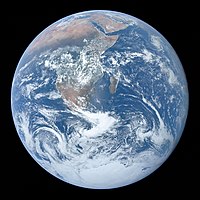
Photo from wikipedia
Abstract Biomass burning is a significant process in the Earth system, driving ecosystem dynamics and changes in global vegetation, and affecting the carbon cycle and climate. Projections of future fire… Click to show full abstract
Abstract Biomass burning is a significant process in the Earth system, driving ecosystem dynamics and changes in global vegetation, and affecting the carbon cycle and climate. Projections of future fire activities require an understanding of the connection between fire history and climate in the past. Polar snow/ice contain long-term records of past climates and fire activity and hold great promise to improve our understanding of wildfire patterns. Here, using ultra-high-performance liquid chromatography-tandem mass spectrometry techniques, we quantified three organic compounds (levoglucosan, vanillic, and syringic acids) released by biomass burning in snow samples collected along a 1250-km transect from the coast to the ice sheet summit Dome A in East Antarctica. Results indicate that these tracers are ubiquitous and have reached the ice sheet summit from the continental emissions in the Southern Hemisphere. These compounds showed high levels close to the coastal areas and decreased to a low level on the Antarctic plateau. The snow samples had similar levoglucosan/vanillic acid (∼45) and levoglucosan/syringic acid ratios (∼243) as aerosols from biomass burning. Multivariate analysis indicates that these compounds were likely derived from the burning of grasses and evergreen broadleaf trees that are widespread in Southern Hemisphere than from evergreen conifers that dominate northern hemisphere fire-prone ecosystems. Snow accumulation rate influenced the levels of these compounds, while coexisting ions had little effect on compound contents in the snow. The low concentrations of levoglucosan at inland sites (mean of 2.7 pg mL−1; versus 3.5 and 3.7 pg mL−1 in coastal and transition zones, respectively) could be associated with the oxidation by OH radicals under sunlight. Our analysis demonstrated that the ubiquity of multiple biomarkers from biomass burning in East Antarctic surface snow can provide baseline concentrations for future studies in Antarctica.
Journal Title: Atmospheric Environment
Year Published: 2019
Link to full text (if available)
Share on Social Media: Sign Up to like & get
recommendations!